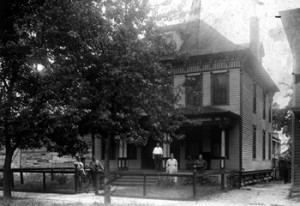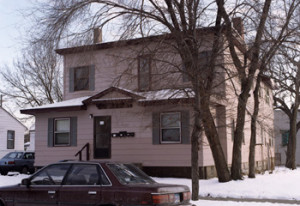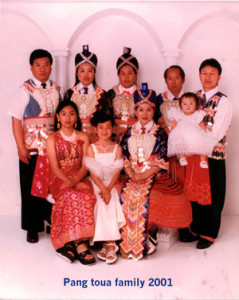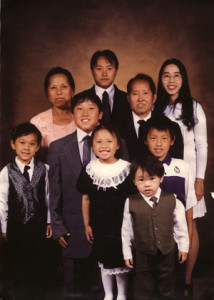Open House

On the snowy afternoon when we first knocked on Pang Toua Yang’s door, he thought he had won something. Actually, we were there to tell him that his house is going to be the subject of a new Minnesota Historical Society exhibit: Open House will tell the story of a single, existing house—Pang Toua’s house on St. Paul’s East Side—and the people who lived within its walls, from the German immigrants who built it in 1888 to the Italians, African Americans, and now Hmong who have followed. The exhibit will be at the Minnesota History Center—Pang Toua’s house will be untouched—but we wanted his support and feared he would tell us, translator Foung Heu and myself, the Hmong equivalent of “hit the road.”
Instead, Pang Toua told us that he and his wife, Mai Vang, had recently become citizens. The previous week they had voted for the first time, helping to elect Mee Moua, the first Hmong legislator in America. Was it their ballot that had led us to their house, they wondered? “They think this is how American democracy works,” smiled Foung after translating their question. Awkwardly I explained that no, their house had been chosen because of its location in the history-rich Railroad Island neighborhood and because, by chance, we had a 1925 photograph of it in our museum’s collection. I waited apprehensively for Pang Toua to say thanks but no thanks. Instead, he let us into his house and, even more generously, shared with us his life story, a story of family, farming, war, and forced migration, of old world and new.
The exterior of Pang Toua’s house is almost unrecognizable from its 1925 incarnation. What pharmacist Albert Schumacher had built in 1888 as a single-family home was by 1910 already a duplex; today it’s a triplex, and Pang Toua and his family enter from a side door. The spacious front porch shown in the photo has long been enclosed. The third floor, where Italian families cured sausages, is gone, destroyed in a 1970 fire. And every remnant of Victorian ornament, flourish, and gewgaw on the facade has disappeared, replaced by smooth pink siding.
The house’s interior furnishings, too, would seem foreign to the German and Italian immigrants who lived there before, but perhaps the stories they tell of relocation and adaptation would resonate. On the wall of Pang Toua’s house are two framed documents—one his U.S. citizenship certificate, the other a record of his service in the CIA-supported army of General Vang Pao in Laos. In 1975, after the American army withdrew from Laos in defeat, Pang Toua and Mai were forced to flee with their parents and their six young children. As they tried to escape into the forest, the Communist Pathet Lao troops opened fire on them. Pang Toua and Mai surrendered, but their parents did not emerge from the woods. Presumably they were killed. After their capture, Pang Toua, Mai, and their children spent four years on a Pathet Lao work farm and two more in a Thai refugee camp before the family faced a choice: stay in the camp, with its continual food shortages and cramped conditions, until it closed; return to Laos and face likely persecution; or come to America. Reluctantly they left their homeland, arriving in Minnesota in 1986.
Settling in St. Paul has been a mixed blessing for Pang Toua and his family. Mai finds life easier here. She and Pang Toua grow vegetables in their garden and in a community farm plot, but the work of putting food on the table is not as taxing as it was on the farm in Laos. Pang Toua and Mai’s children have embraced America. Their oldest daughter, Mee Yang, has become an entrepreneur. Tired of people pronouncing her name as if it rhymes with “sang” instead of “sung,” she has changed it to Elizabeth Young. She now owns fourteen properties, including the house on Hopkins Street, part of which she rents to her parents. When I meet her, she teases me for owning “only” one home.
Pang Toua himself is struggling to navigate between American and traditional Hmong cultures. He tells me he would be happy to help on the exhibit project because, “In Laos, I was a useful person—my own farmer, my own blacksmith. Here I can’t do anything.” Compounding his feeling of dislocation, he recently suffered a terrible accident. He had a dream that some children were poking a bee’s nest with a stick and that the bees swarmed out and stung his whole body. The next week, he recounts, he was grilling in his backyard. The bottle of lighter fluid he was using had a hole in it, causing flames to shoot up and burn him severely. To Pang Toua, these stories—the dream and the accident—are connected. And so he has consulted both Western doctors and Hmong shamans to treat the injuries he suffered. The first thing one sees upon entering the Hopkins Street house is a shaman shrine. “If it’s a disease,” Pang Toua tells me, “then doctors can cure it, but if it’s spiritual, then you need shamans.”
Thrilled that our initial conversation with Pang Toua has gone so well, Foung and I decide that the next step is to give him and his family more of a sense of what they’re getting into; we will invite them to our museum building, the Minnesota History Center. Foung calls them a couple of weeks after our first meeting and arranges the visit. Cheerfully I say to Foung that it’s a good sign that they are interested in coming. “Well,” Foung says evenly, “in my culture once we invited them they pretty much had to come”—a system of mutual social obligation that any Minnesotan bearing a hotdish would recognize. In the week before the Yangs’ visit to the museum, I obsess about details. “Do you think Pang Toua and his family would like turkey, ham, or cheese?” I nervously ask Foung. I’ve been reduced to asking a consultant for advice on sandwich selections; even lunch becomes a minidrama when you’re working across cultures. Foung, a world-class culture straddler, smiles patiently and gives me just what I need, a decision: “Let’s go with ham.”
On the day of the visit, my nervousness at first seems to have been well justified. Foung and I have arranged to meet the Yangs at their house at 11:00 a.m. That morning Foung leaves me a message saying he’ll see me there at 10:45. Confused, I call back. Yes, Foung says, we arranged 11:00, but they will expect us to come and mingle first. So, I arrive at 10:45 and knock on the door. Their youngest daughter, a teenager, lets me in with complete indifference. Pang Toua and Mai don’t say a word to me either. The only sound is from the TV—what seems to be a documentary about the Mayans, droning on with no one watching. It feels like hours later but is probably only 10:46 when Foung arrives and we all get moving. We go next door, where daughter (and landlord) Elizabeth and her husband Michael live, and then we all pile into the ridiculously large state-owned van I’ve brought.
At the History Center, conversation gets somewhat easier. The ham sandwiches are devoured, and the exhibits are looked at with quiet interest. I make a point of showing them an exhibit on music in Minnesota that includes a hand-made Hmong instrument called a qeej and video footage from a Hmong nightclub in St. Paul. Pang Toua and Mai are more impressed with a different exhibit, one about Minnesota’s notorious weather, in which a huge fabric tornado spins. They have their picture taken in front of it.
Next we go behind the scenes, underground to where the Historical Society’s artifact collections are preserved for posterity in state-of-the-art, humidity-, temperature-, and light-controlled environments. Collections curator Claudia Nicholson shows Pang Toua and Mai the objects of Hmong culture that the Historical Society has accessioned—woefully few, really—and explains, through Foung, that we are eager to do more to document the contemporary Hmong experience in Minnesota. Out of nowhere, Mai, who has been almost silent to this point, says, “So when we’ve lost our traditions we can come here and learn them from you.”
After the museum tour, we head back to Hopkins Street for a more extended look at the house, an object clearly of more interest to me than to them. Walking in, I’m immediately struck by the warm rush of a strong food smell that I remember from the first time I stood in Pang Toua’s doorway—boiled chicken, maybe, but with an unfamiliar pungency. A large pile of shoes overflows a bin by the door, and I add mine to the sheet of plastic next to it. Pang Toua and Mai immediately move back into their lives, so the job of showing us around falls to landlord and son-in-law Michael. The tour is short because the unit really only has four small rooms, all crammed full with objects. In the living-dining-kitchen area, Mai and her teenaged daughter are serving a rice and vegetable mixture from a huge bowl to grandchildren, while the TV continues to blare, cartoons this time. To the side is a tiny bedroom where Pang Toua’s teenaged sons sleep and behind it is another (formerly an enclosed porch) for his daughter. In a back bedroom off the kitchen, Pang Toua has changed back into more casual clothes and is adjusting the protective sleeve on his injured arm. I see trays of green seedlings in the room, but Michael is unable to identify the plants for me. A back door leads out to the snow-covered garden. An internal stairway off the kitchen, which leads to the upper-floor apartment unit (occupied by another Hmong family), is completely blocked with objects—an improvised closet. Another small space off the kitchen, probably once a side porch, holds more overflow objects, including a large freezer.
Later, I ask Foung whether he thinks Pang Toua and Mai will stay in this house or move to another place. “Oh, I think they will be there a long time.” Then I raise the question I really have in mind: if Elizabeth owns fourteen properties, why does she put her parents in such a small, cramped space? “Well it’s part of our culture to save the worst for ourselves,” says Foung. “But in this case, it’s not herself; it’s her family,” I say. “In our culture,” Foung says simply, “the family is you.”
Heading back to the museum, I think about how far Pang Toua and Mai have traveled—from mountain farm to refugee camp tent to this house that, in my mind’s eye, is all tangled sheets. How do they make sense of the distance they have traveled? Or has part of them never left? Is their world contained by 470 Hopkins Street, or is part of them elsewhere? To me, the house is a powerful framing device, but somehow I doubt it contains their core.
Pang Toua and Mai’s tale is only one of many wrenching, buoyant, comic, and tragic stories we’ve uncovered in researching the fifty families who passed through 470 Hopkins Street between 1888 and 2003. Strikingly different in their details, these life stories share a rich and idiosyncratic humanity that one could never script. As we delve into census records, birth records, marriage and death records; page through faded family photo albums; and talk to anyone who might have known someone who might have once lived in this house, we are gaining a sense of the texture of history and of home: how ordinary people build their lives within four walls and within circles of family, ethnicity, neighborhood, city, and nation. The house has become a vessel of dreams, a stage for successes, setbacks, tragedies, and transformations. Number 470 Hopkins Street has led us into worlds richer than we could have imagined—worlds where the boundaries between Old World and New World blur, where “American” takes on layers of meaning that transcend any dictionary definition, and where a knock on the door can open up conversations that reach across cultures, geography, and time.
Further reading:
The idea of building a major exhibit around a single, seemingly ordinary house comes most directly from the rich work done by the Lower East Side Tenement Museum in New York City. That ongoing project is described at www.tenement.org and in two books: A Tenement Story: The History of 97 Orchard Street and the Lower East Side Tenement Museum by Stuart Miller (New York, 1999), and, for younger readers, 97 Orchard Street, New York: Stories of Immigrant Life by Linda Granfield (Plattsburgh, 2001). A somewhat similar approach was taken by the Smithsonian Institution in its exhibit Within These Walls. The exhibit’s Website features curricular materials and how-to tips on house research. More broadly, the impulse to tell a narrowly bounded story comes out of a vein of narrative-driven history, including (among many examples) Carlo Ginzburg’s The Cheese and the Worms (Baltimore, 1980), Laurel Thatcher Ulrich’s A Midwife’s Tale: The Life of Martha Ballard, Based on Her Diary, 1785-1812 (New York, 1990), John Demos’s The Unredeemed Captive: A Family Story from Early America (New York, 1994), Nick Salvatore’s We All Got History: The Memory Books of Amos Webber (New York, 1996), Patricia Cline Cohen’s The Murder of Helen Jewett: The Life and Death of a Prostitute in Nineteenth-Century New York (New York, 1998), Carlo Rotella’s Good with Their Hands: Boxers, Bluesmen and Other Characters from the Rust Belt (Berkeley, 2002), and Jill Lepore’s A Is for American:Letters and Other Characters in the Newly United States (New York, 2002). The complicated situation of the Hmong in America is recounted movingly in Ann Fadiman’s spellbinding The Spirit Catches You and You Fall Down (New York, 1997). Examples of Hmong folklore are compiled in Charles Johnson’s Dab Neeg Hmoob: Myths, Legends and Folk Tales from the Hmong of Laos (St. Paul, 1981).
This article originally appeared in issue 3.3 (April, 2003).
Benjamin Filene is an exhibit developer at the Minnesota Historical Society in St. Paul and the author of Romancing the Folk: Public Memory and American Roots Music (Chapel Hill, 2000), which won an ASCAP-Deems Taylor award and the American Historical Association’s Herbert Feis Award. The Open House exhibit will open for a five-year run at the Minnesota History Center in January 2005.



